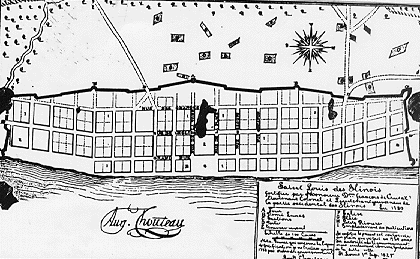 Early Beginnings in St. Louis
Early Beginnings in St. Louis Early Beginnings in St. Louis
Early Beginnings in St. LouisBelow is an image of an early French map of St. Louis
by Auguste Chouteau.
 |
Thirty years before James Piggott arrived in Cahokia, French fur traders had established a settlement on the western side of the Mississippi. Pierre Laclede and Auguste Chouteau sought to establish a fur trading outpost to attract Native Americans and their bounty of furs. Auguste was the thirteen year old stepson of Laclede, who worked for a New Orleans trading company. Almost twenty miles south of the convergence of the Mississippi and Missouri Rivers they found the western shore had both access to the river and a high bluff offering protection from flooding. In 1764 Laclede returned to the site with his stepson and a settlement party. They named their settlement St. Louis after Louis IX of France. (Louis IX ruled France from 1214 to 1270 and was canonized in 1297. He was beloved by the French for his benevolent reign, improvement of finances in the kingdom, work toward peace and prosperity, and initiation of the right of direct appeal to the Crown in all cases.)
St. Louis, initially nothing more than rows of cabins, became a center for trade along the Mississippi River. As it developed, the settlement was designed in the fashion of a colonial French city. Unlike the cabins in Illinoistown, St. Louis featured vertically placed logs covered in plaster. The French were not, however, the only group to build St. Louis. Soon after it was established some French-Canadians brought African slaves. Native Americans also came into the settlement to trade and it is possible some stayed.
Laclede did not learn until after St. Louis was established that France had signed a treaty ceding French possessions west of the Mississippi River to Spain. This made St. Louis, a mostly French settlement, a Spanish town. Thus the early period of St. Louis was marked by Spanish government and French culture.
When America went to war with Britain, the Spanish and French joined against the British. In 1780 St. Louis faced a siege by Native Americans fighting for the British. Advanced knowledge of the planned attack allowed the townspeople to construct defenses and a small stone tower they called Fort San Carlos. Their defensive measures were enough to keep the British from mounting a strong attack.
|
St. Louis remained a fur trading outpost during its first forty years, becoming a gathering pace for goods and people heading south to New Orleans. The town was becoming a city by 1800 when there were around one thousand inhabitants. It was changing in appearance as people replaced the original log cabins with more substantial stone houses and buildings.
|
Napoleon Bonaparte had conquered Spain and its possessions and was willing to sell a good deal of it to the United States in order to raise the funds necessary to maintain his army. The United States completed the Louisiana Purchase in 1803. St. Louis was the capital of Upper Louisiana at the time and President Thomas Jefferson selected it as the site for the formal transfer of power from the French. On March 10, 1804 the United States took formal possession of Louisiana territory and St. Louis became the central point for the westward expansion into this new acquired land.